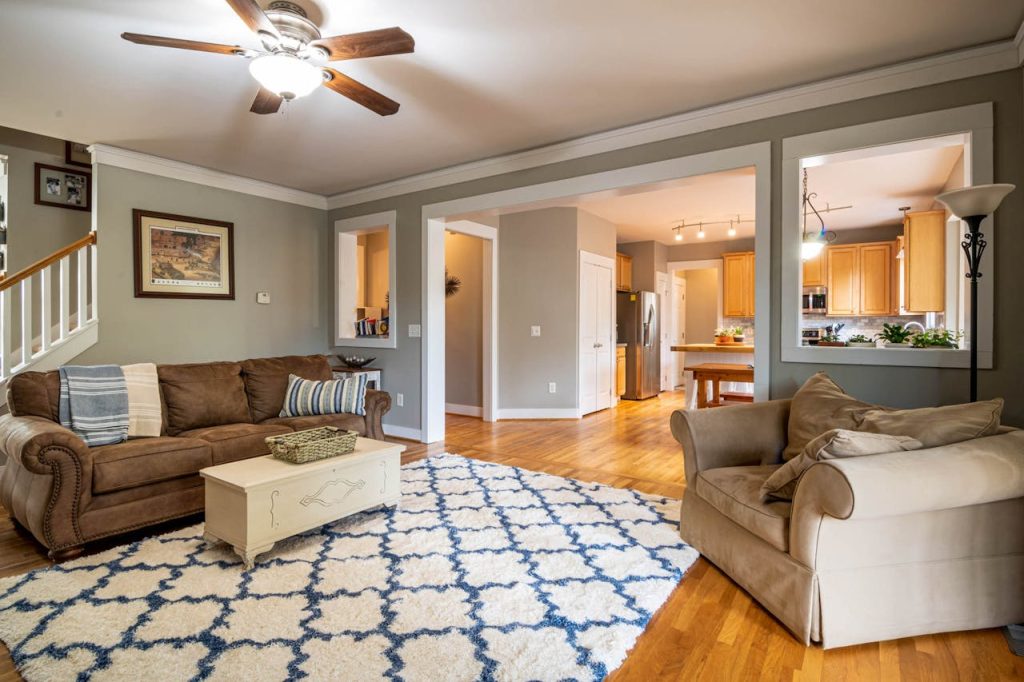Written by Nyla Thompson, founder of DecorifyIt and a certified home improvement specialist with over 15 years of hands-on design experience. Nyla has consulted on hundreds of UK hallway makeovers—from period homes in Bath to contemporary flats in Manchester—helping clients make smart rug choices that elevate first impressions.
The entry hall is the first impression your home makes—and the rug you choose plays a surprisingly big role in setting the tone. Whether you live in a spacious house or a compact flat, a rug can pull the look together, protect your floors, and help the space feel more put-together.
But choosing an entryway rug isn’t just about picking something that looks nice. Size, material, shape, and even what you place under the rug can impact both design and functionality. Let’s walk through the essential rug rules to get it right the first time.
Size Matters More Than You Think
One of the most common rug mistakes? Going too small. A rug that barely touches the edges of your hallway makes the space feel disjointed and undersized. Oversized rugs can overwhelm or block doors.
To get the size right:
- Measure the width of your hallway and subtract around 20–30 cm on each side. This leaves a clean border that frames the rug.
- Add extra length if you’re placing it under furniture like a console or bench—aim for 60 cm of rug beneath the piece for visual balance.
I once worked on a London townhouse with a grand double-door entry. The homeowner had a tiny doormat in the middle—it looked like an afterthought. We swapped it for a custom wool runner that extended wall to wall, just shy of the edges, and instantly the space felt cohesive and luxurious.
If you’re shopping online for an entryway rug, always check the full dimensions instead of eyeballing it from photos. The correct rug size not only enhances the look—it improves the feel and flow of the space too.
Material Makes a Difference
Your entry hall sees a lot of traffic. That means your rug needs to be tough, easy to clean, and resistant to wear and tear. Some materials handle these demands better than others.
- Wool is a standout for softness and durability. It hides dirt well and springs back after pressure.
- Polypropylene or nylon rugs are budget-friendly and stain-resistant, ideal for households with pets or kids.
- Jute or sisal offer a rustic, natural feel but may break down quickly with moisture or heavy use.
Avoid delicate fabrics like silk or velvet in this zone—they simply won’t survive muddy boots or rainy-day foot traffic. Low-pile options are best if your rug will sit under furniture or in a tight doorway.
Match the Shape to Your Space
A rectangular rug is often a natural fit for long, narrow hallways. But if your entry hall is square, a round or oval rug might make the space feel more inviting by softening sharp corners.
Observe how people walk through the area. A runner that follows the path keeps the space open and intuitive. If your layout includes double doors or a split layout, two smaller rugs can work—just stick to a matching style or color to maintain visual harmony.
During one of my hallway redesign projects in Brighton, a client had two entrances merging at an awkward angle. We used two oval rugs with a shared colour scheme—one under the bench, one near the inner door—and the symmetry completely reshaped the feel of the space.
Inspiration from House & Garden UK suggests that consistent design elements in hallways make transitions between rooms feel smoother and more considered.
Don’t Forget the Rug Pad
Many homeowners skip the rug pad—and it’s a big mistake. A proper rug pad not only keeps your rug in place but also protects your floor and improves comfort underfoot.
- Felt-backed pads add softness but may be too thick near doors.
- Rubber-backed pads grip well but must be non-marking to avoid stains.
- Combination pads (felt + rubber) often strike the right balance, especially for hardwood or tile floors.
According to guidance from the Nevada Division of Emergency Management, a loose rug is a top cause of entryway falls—especially for older adults. A good pad reduces that risk.
Make It Practical, But Pretty
Choosing a rug that’s both stylish and durable doesn’t have to be hard. Go for colors and patterns that hide everyday messes like dust, pet hair, or shoe marks. Mixed tones or darker hues work well. Lighter colors can brighten the space but need more frequent upkeep.
Look for features like:
- Stain-resistant finishes
- Machine-washable designs
- Fade-resistant fibers if your hall gets strong sunlight
Flatweave and low-pile rugs are easiest to clean, especially if your entryway connects directly to the outdoors. That means less time spent vacuuming and more time enjoying your space.
Final Thoughts
When chosen thoughtfully, an entry hall rug does much more than cover the floor—it becomes part of the welcome. With the right size, shape, material, and pad, you’ll enhance not just the look of your hallway but how it feels to come home.
It’s a small change with big impact. So before you roll out the welcome mat, take a moment to make sure your rug does its job beautifully and safely.

